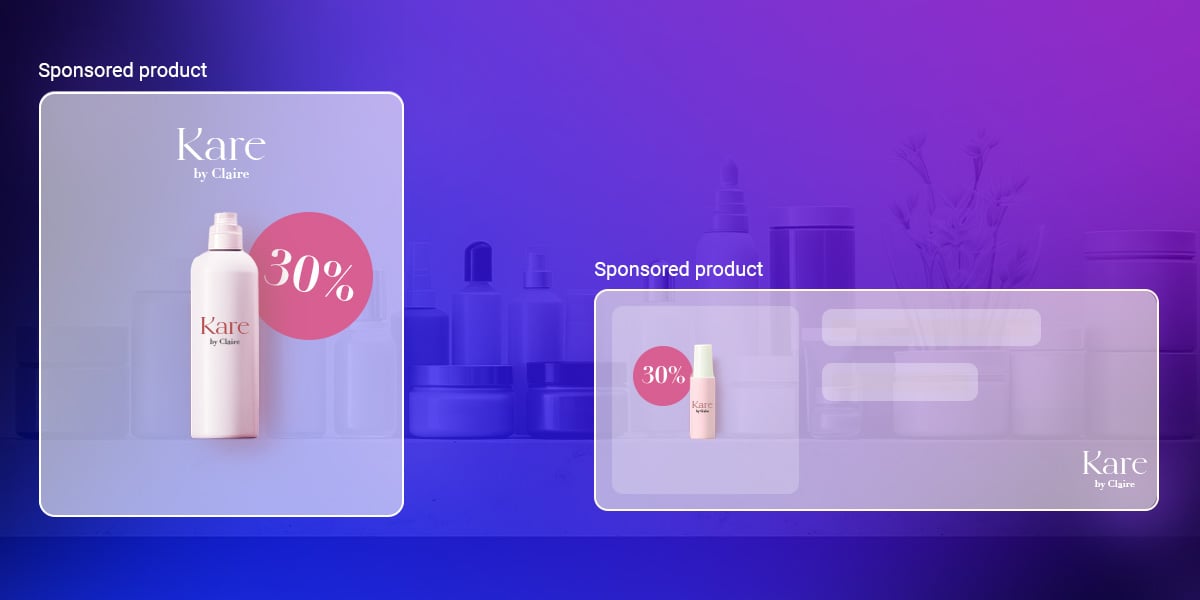Retail Media is pivotal for brands aiming to engage consumers directly on retailers' digital platforms and apps. As these platforms burgeon and amass a wealth of customer data, a new realm of targeted advertising opportunities emerges, necessitating a strategy distinct from traditional digital advertising. Campaigns should be meticulously aligned with each retailer’s unique business objectives and insights into shopper behaviour.
Here are some best practice techniques to take into consideration when approaching your retail media campaigns to ensure you generate results that are beneficial to your business goals.
Audience-Centric Approach
In the domain of brand awareness, traditional media has predominantly concentrated on extensive demographic and psychographic reach. In stark contrast, Retail Media necessitates the meticulous segmentation of audiences.
Initiating your Retail Media strategy involves pinpointing your fundamental audience, grounded on tangible purchasing data and consumer behaviours. It is imperative to harness first-party loyalty data available through various retail media networks or platforms, amalgamating it with your proprietary CRM and customer data.
This methodology enables brands to reconnect with established customers and identify prospective high-value shoppers who engage with your category, but have not yet interacted with your brand. It is crucial to resist the allure of exclusively targeting avid category purchasers and instead, strive for incremental reach.
Crafting customised audiences and segmenting them distinctively for each significant retail media collaborator is a requisite. A content supermarket consumer may exhibit diverse characteristics when compared to an Amazon Prime subscriber. Collaborating with data specialists is essential to cultivate audiences that are bespoke for each retail environment.
Articulation of Clear Objectives
Venturing into retail media necessitates a well-defined core objective and KPI. Articulate what you specifically aim for retail media to accomplish, whether it is driving sales, reactivating buyers, launching a new product, or growing market share.
Typical objectives include:
- Drive sales/share within a retailer
- Reactivate lapsed buyers
- Increase margins by promoting premium items
- Grow overall market share against competitors
- Launch a new product
The initial objective serves as the cornerstone, informing audience targeting, messaging, creative strategy, and the measurement of success. In the absence of a well-defined objective, retail media endeavours are at risk of deviating from their intended path.
Apt Selection of Retail Media Formats
It is imperative for businesses to harness a variety of advertising products and placements offered by each prominent retailer, selecting formats that align seamlessly with your objectives, budget, and target audience.
- Paid Search: This approach allows you to target audiences using specific keywords as they search for products. It is an exceptional method for fulfilling demand and introducing new items to the market.
- Product Listing Ads: These ads are designed to promote individual products on category and search pages, acting as a catalyst for product discovery and driving conversions.
- Site Display: Utilising banners and video, this format is instrumental in promoting brand awareness and consideration, making it an optimal choice for upper-funnel strategies.
- On-site Recommendations: By featuring products on browse pages through sponsored categories or cross-sells, this strategy aids in augmenting basket size.
- In-store Digital: The integration of digital displays and smart carts bridges the gap between online and offline data, fostering awareness and serving as gentle reminders for consumers.
It is advisable to construct campaigns that incorporate several formats, contingent on budget and overarching strategy. Additionally, we strongly recommend conducting pilot tests on new formats on a smaller scale prior to a full-scale roll-out.
Crafting of Relevant Content
Retail media presents an unparalleled opportunity to achieve tighter targeting compared to the wider spectrum of digital media. This distinctive advantage should be leveraged to craft creative assets and messages that are not just relevant but also customised to meet the unique needs and preferences of the audience.
- Leveraging Dynamic Product Listing Ads: Dynamic Product Listing Ads (DPLAs) are a powerful tool in the arsenal of retail media. They afford advertisers the ability to spotlight specific products they wish to highlight. By integrating tailored copy and exclusive offers, both search and display ads can be customised explicitly for the retailer, thereby enhancing the potential for customer engagement and conversion.
- Localised In-Store Digital Presence: A robust localised in-store digital presence is instrumental in fortifying your brand’s creative footprint on-site. It serves as a direct interface with the consumer, reinforcing brand imagery and values while fostering a more personalised and immersive shopping experience.
- Delivering Valuable Information: Providing the audience with insightful information is pivotal. This could encompass nutritional benefits, ideal usage occasions, and salient features of the product. Such information should be meticulously tailored based on the specific audience to enhance relevance and resonance.
- Avoiding Static Brand-Only Creative: In the dynamic world of retail media, static brand-only creative assets can be limiting. It is imperative to steer clear from a one-size-fits-all approach. Instead, efforts should be concentrated on customising content that caters to the individual shopper, the retailer, and the nuances of the local store.
The more creative and audience-focused your creatives are the more, the bigger the likelihood of them connecting with your audience and helping you to achieve your goals.
Continuous Optimisation Cycle
Approaching retail media optimisation demands a cyclical, rather than linear perspective. Continuous monitoring, adjustment of strategies, and meticulous result tracking are paramount to generating the results that lead to success.
- Focus on Key Performance Indicators (KPIs): Key metrics such as clicks, added-to-cart rate, sales, and Return on Ad Spend (ROAS) are instrumental in understanding what truly resonates with your audience. It’s essential to optimise according to your specific campaign objectives, rather than solely concentrating on reducing the cost per click.
- Regularly Refine Audience Targeting: It is crucial to consistently review and adjust audience segments. Depending on the campaign's performance, either expand or narrow your targeting to ensure maximum reach and effectiveness. The periodic rotation of creatives aids in identifying top performers and optimising the campaign accordingly.
- Balance Spend and Performance: Adjusting bids, budgets, and placements regularly is a fundamental step in balancing expenditure and campaign performance. Such adjustments allow for a more efficient allocation of resources, ensuring optimal results.
- Cultivate Optimisation Agility: Developing agility in optimisation is a blend of experience and learning. It is vital to leverage the expertise of retail media professionals who can interpret complex data, uncover invaluable insights, and implement modifications that lead to campaign success.
Optimising retail media is an ongoing, iterative process. By adopting a cyclical approach, focusing on key metrics, refining audience targeting, balancing spend, and fostering optimization agility, advertisers can significantly enhance campaign performance.
Alignment with In-Store Promotions
To optimise the effectiveness of retail media campaigns, it is essential to have a strategy that can align your online efforts with the in-store experience. For example, providing in-store representatives with relevant preview creatives and tailored messaging that enhance your retail media campaigns can be extremely beneficial to driving conversions.
Such a practice ensures that in-store activations aptly complement and reinforce overarching strategic objectives, thereby presenting a harmonious narrative through the synchronisation of online and in-store offers and products.
Additionally, leveraging geo-targeting for digital advertisements augments their relevance by tailoring them to customers in proximity to specific stores that are conducting promotions. Major retailers such as Walmart exemplify this approach by permitting sponsored product campaigns to exclusively promote items available at designated stores.
Achieving alignment through an omnichannel approach is instrumental in fostering consistent messaging, thereby enhancing the overall impact of campaigns. This harmonised approach not only amplifies the resonance of the campaign but also fortifies collaboration between digital and in-store teams, creating a unified front in retail media strategy.
By integrating these best practices, retail media can be harnessed to its fullest potential, bridging the digital and physical realms of consumer interaction, and ultimately driving both online and in-store sales.
Measurement of Incremental Lift
In the realm of Retail Media, comprehending the incremental return from investments is paramount for brands. A mere evaluation through Return on Ad Spend (ROAS) does not illuminate the comprehensive scenario.
It is imperative for brands to collaborate with retailers who facilitate the formation of adequate holdout groups for refined measurement. Utilising instruments such as IRI Media Sales Effect and Nielsen’s Diameter are instrumental in quantifying the uplift compared to the baseline established before the initiation of a campaign. Such tools enable brands to meticulously assess the sales uplift for the individual products being promoted.
This method of incremental measurement serves as the quintessential indicator of the effectiveness of Retail Media. It not only assists brands in substantiating continuous investment but also acts as a catalyst in broadening their horizon by venturing into collaborations with new retailers. It is advisable not to be exclusively reliant on ROAS estimates provided by the seller, without conducting an independent analysis of the lift.
Recognition of Channel-Wide Benefits
In assessing your retail media marketing efforts, it is imperative to adopt a holistic approach, transcending the constraints of individual channels. For an encompassing view, one should scrutinise the cumulative impact of sales across various retailers, encompassing both digital and brick-and-mortar platforms.
Employing statistical modelling is essential in gauging the aggregate uplift across diverse retail media channels. It is advisable to survey consumers who have encountered retail media advertisements and meticulously track their in-store purchases. These methodologies are instrumental in quantifying the authentic sales halo effect.
Moreover, financial modelling serves as an illuminating tool, unveiling the profound impact of retail media on the composition of marketing models. When aptly allocated based on sales contribution, retail media is poised to constitute a growing fraction of overall media attribution.
By adhering to these best practices, businesses can effectively leverage Retail Media to optimise their market presence and bolster sales, thus ensuring a competitive edge in today's dynamic retail environment. Adopting a comprehensive and strategic approach is essential for harnessing the full potential of Retail Media.
Looking Ahead:
As retail media evolves, brands will face increased scrutiny on performance and attributable impact. Following these best practices enables your brand to harmonise brand objectives with performance delivery.
Those adopting an omnichannel approach will lead as the boundaries between digital and physical retail continue to blur and adhering to these best practices is crucial in leveraging Retail Media to its utmost potential, thereby ensuring that brands can make informed decisions and optimise their investment strategies effectively.







